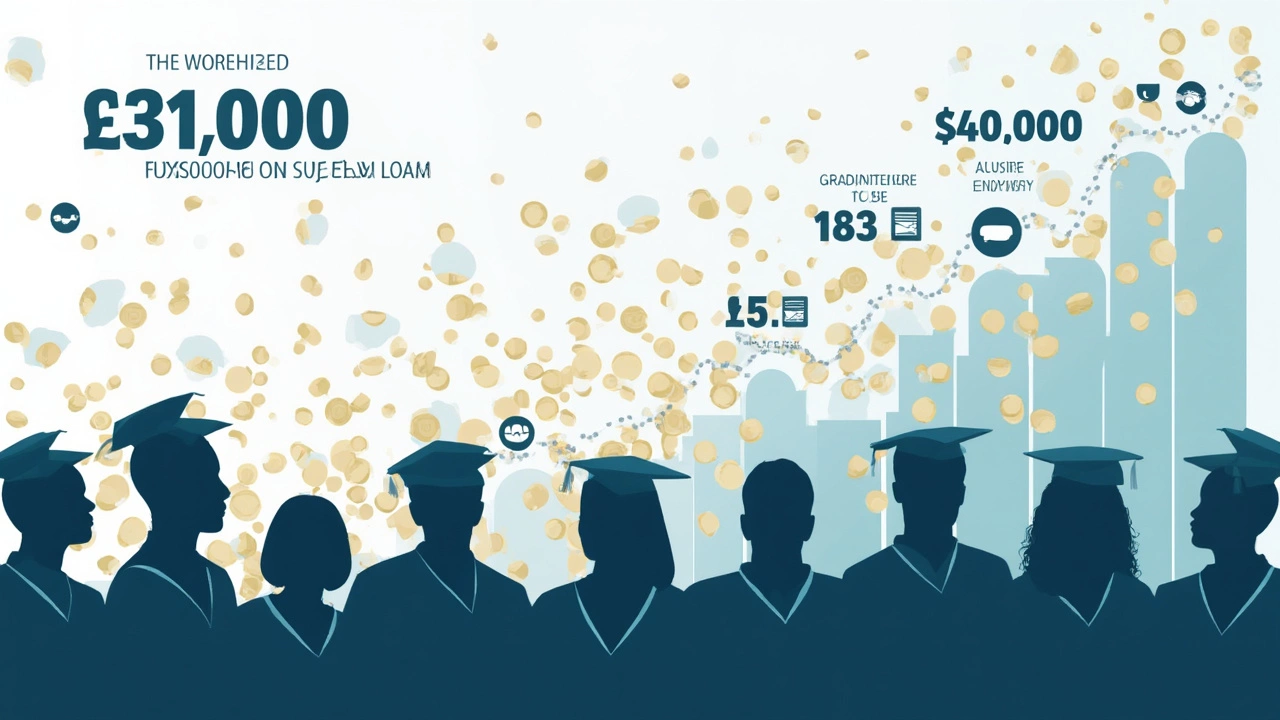Staring at $40,000 in student loans can feel like a punch to the gut, especially when you’re getting those first repayment emails. You might be asking yourself, is this normal? Or is this going to haunt you financially for years?
Here’s the honest truth—$40,000 in student loan debt isn’t rare, but it isn’t exactly “lightweight” either. According to the Federal Reserve, the average borrower owes just under $38,000 right now, so you’re actually a little above average. But context matters a lot. Did you go to grad school? Is your major likely to land you a high-paying job? Are your loans mainly federal or private? All of those details can swing how much $40,000 actually means for you, month to month.
- What Does $40,000 in Student Loans Look Like?
- How $40,000 Compares to the National Average
- Monthly Payments and Your Day-to-Day Life
- Career Choices: Will Your Degree Pay Off?
- Tips for Tackling $40,000 in Student Debt
What Does $40,000 in Student Loans Look Like?
When you see $40,000 in student loans on your balance sheet, you’re looking at a pretty average debt for a bachelor’s degree these days. For federal student loans in the U.S., the payment terms are usually around 10 years, but you can extend it to make monthly bills lower (though you’ll pay more interest in the long run).
If you borrowed all $40,000 at the standard federal interest rate—let’s say about 5.5%—and picked a 10-year payoff plan, your monthly payment would land around $435. That’s a hefty chunk, especially if you’re just starting out in your career or juggling rent and other bills.
Here’s how it breaks down compared to some other numbers:
| Loan Amount | Interest Rate | 10-Year Monthly Payment |
|---|---|---|
| $20,000 | 5.5% | $218 |
| $40,000 | 5.5% | $435 |
| $60,000 | 5.5% | $653 |
Most student loan debt comes from federal loans, which have flexible payment options. Private loans are trickier—they can have higher rates and fewer forgiveness programs. Either way, $40,000 is usually made up of multiple years of borrowing—not just one year’s tuition.
To put it in perspective, $40,000 could cover a full four years at an affordable public college, but wouldn’t even come close for private universities. Factor in room, board, and living costs, and it’s easy to see how balances climb. If you added grad school on top, $40,000 can start to look small compared to what some owe.
Bottom line: $40,000 in student loans is a serious commitment. It’s not crushing, but it does shape your financial choices after school. Knowing exactly what you’re dealing with gives you power—so break down your total, list out your loan types, and make a plan as soon as you can.
How $40,000 Compares to the National Average
When it comes to student loans, $40,000 might make you sweat, but let’s see how that stacks up nationally. According to the U.S. Department of Education, as of 2024, the average federal student loan debt per borrower sits at just under $38,000. So if you owe $40,000, you’re a bit above that average—by a couple grand—not totally off the charts, but it’s not pocket change, either.
When you dig deeper, things get interesting. Most people with a bachelor’s degree only, graduate with about $29,000 in federal loans. Those higher numbers—think $40,000 or more—are much more common among folks who went to grad school, or who mixed in private loans for pricier colleges.
| Degree Level | Average Student Debt (2024) |
|---|---|
| Bachelor’s | $29,000 |
| Graduate/Professional | $71,000 |
| All Borrowers (Federal + Private) | $37,800 |
If most of your $40,000 is federal, there’s at least some breathing room thanks to flexible repayment plans. But if a big chunk is private loans, watch out for less wiggle room and higher interest rates.
Maybe you’re wondering, "How on earth did people rack up this much debt?" Well, it’s not just tuition—room, board, fees, and even textbooks can add up fast. And if you come from a state where in-state public schools don’t offer much aid, you might hit that $40,000 mark quicker than you’d think.
The bottom line: $40,000 puts you a little over the national average, especially compared to undergrad-only borrowers. But you’re definitely not alone—about 1 in 5 borrowers owe more than $50,000, so you have a lot of company in that boat.

Monthly Payments and Your Day-to-Day Life
Let’s get real—having student loans totaling $40,000 means you’re making a real impact on your monthly budget. Most federal student loans use a standard 10-year repayment plan. Right now, the interest rate for new federal loans is hovering around 5.5% to 7% (depending on the type), so let’s do the math for a second.
If you owe $40,000 at an average rate of 6%, the monthly payment on a 10-year plan lands around $444. Plugging that into your budget quickly shows it’s more than just a minor bill. For a lot of new grads, that’s rent money or even a car payment. Just to make it super clear, here’s a quick breakdown:
| Loan Amount | Interest Rate | Term | Monthly Payment |
|---|---|---|---|
| $40,000 | 6% | 10 Years | $444 |
| $40,000 | 7% | 10 Years | $464 |
Paying off $40,000 debt with these monthly payments can absolutely squeeze your day-to-day life. That’s why a ton of people turn to income-driven repayment plans. These can drop your payment way lower, sometimes under $200 a month, but you’ll probably be paying longer and possibly shelling out more in interest over time.
Other real-life impacts? When you’re making these payments, it often means you hold off on other big steps: things like buying a house, saving for a wedding, even taking vacation might get put on the back burner. Lenders check your debt-to-income ratio, and $40,000 in student debt can make getting approved for other loans tougher. And sometimes, all that money going to your loan each month means your emergency fund barely grows.
Thinking of refinancing? Sometimes it helps if you have a good job and a steady income, but be careful—if you refinance federal loans with a private lender, you lose all the federal protections like deferment or income-based options. Always compare your options and do the math for your exact situation.
Career Choices: Will Your Degree Pay Off?
Here’s the hard truth—not all degrees make paying off student loans equally easy. What you studied and what job you land really changes the math on that $40,000 bill.
If you’re walking into a field like nursing, engineering, or computer science, you’re looking at stronger starting salaries. For instance, U.S. Bureau of Labor Statistics shows the median pay for registered nurses is around $81,000 a year, while software developers hit $127,000. These numbers make a $40,000 balance a lot less scary, especially if you keep other expenses in check.
Meanwhile, if your degree is in a field where average starting pay sits closer to $40,000 to $50,000—think social work, teaching, or the arts—monthly loan payments can feel a lot heavier. It doesn’t mean your choice was wrong, but it might take some juggling to stay on top of loans and bills.
Check out typical starting salaries for popular majors to see where your paycheck might land:
| Major | Typical Starting Salary |
|---|---|
| Computer Science | $78,000 |
| Business Administration | $58,000 |
| Education | $44,000 |
| Psychology | $42,000 |
| Mechanical Engineering | $74,000 |
| Fine Arts | $41,000 |
If your future income seems tight, you’ve still got options. Some graduates with modest salaries look into income-driven repayment plans, Public Service Loan Forgiveness (PSLF), or side gigs. Also, a lot of states and some employers offer bonuses or loan repayment help for teachers, social workers, nurses, and other high-need jobs.
Bottom line: Before panicking about those $40,000 debt numbers, check what your field really brings in. Not every path is a tech salary, but some jobs come with their own financial perks you might not expect right out of school.

Tips for Tackling ,000 in Student Debt
So you’ve got $40,000 in student loans. That number can feel intimidating, but there are proven ways to take charge. You don’t need fancy financial skills—just a solid plan and a willingness to stick with it. Let’s break it down into simple actions you can actually start right away.
1. Choose an Affordable Repayment Plan
- If your loans are federal, look at income-driven repayment (IDR) plans. Your monthly bill could be cut down to 10% of your discretionary income. This frees up cash flow and keeps you afloat even on an entry-level salary.
- Got private loans? See if you can refinance for a lower interest rate—especially if your credit score has jumped since graduation. Pay attention to fees and terms, though.
2. Automate Your Payments
- Auto-pay often knocks 0.25% off your interest rate with most servicers. Even if it sounds small, it adds up over time and can save you hundreds of bucks over years of repayment.
3. Pay More Than the Minimum
- Even tossing an extra $25 or $50 per month at your student loans can slash your total interest—and you’ll be done sooner. Make sure those extra payments go toward your principal, not future interest.
4. Look Into Forgiveness or Relief Options
- If you work in public service, education, or non-profits, check out Public Service Loan Forgiveness (PSLF). After ten years of qualifying payments, the rest of your loan could be wiped clean.
- For some teachers and nurses, state and federal programs offer partial or full loan cancellation. Requirements vary, so dig into the details for your field.
5. Consider a Side Hustle
- If your day job isn’t cutting it, picking up a side gig—even temporarily—can pile on extra payments. There are endless ways to earn a bit more, from dog-walking to designing websites.
Student loan debt isn’t always forever. The Department of Education reported in 2024 that borrowers who pay even slightly more than their minimums typically clear $40,000 in loans 2-3 years earlier than those sticking to minimum payments.
| Monthly Extra Paid | Loans Paid Off Early (Years) |
|---|---|
| $0 (minimum only) | 0 |
| $50 extra | About 2 years |
| $100 extra | About 3 years |
"Choose a plan you can actually stick to. Paying back loans is a marathon, not a sprint," says Betsy Mayotte, President of The Institute of Student Loan Advisors.
Most important? Know your options, keep looking for new angles, and don’t let that $40,000 number scare you into silence. With the right strategies, you’re definitely not stuck.
